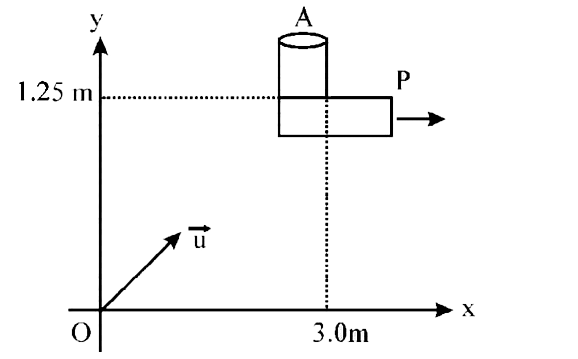A object is slide along the frictionless floor with intial volocity (a) Describe the motion of the object relation to car (b) when does the object reach its original position relative to the box car.
(a) With respect to box (Non-inertial)

(b) at (say)
:. To return to the original position time taken
Topper's Solved these Questions
- BOOK - DC PANDEYCHAPTER - LAWS OF MOTIONEXERCISE - Objective Question32videos
LAWS OF MOTION
- BOOK - DC PANDEYCHAPTER - LAWS OF MOTIONEXERCISE - Comprehension9videos
LAWS OF MOTION
- BOOK - DC PANDEYCHAPTER - LAWS OF MOTIONEXERCISE - Exercise 8.52videos
LAWS OF MOTION
- BOOK - DC PANDEYCHAPTER - KINEMATICS 1EXERCISE - INTEGER_TYPE15videos
KINEMATICS 1
- BOOK - DC PANDEYCHAPTER - LAWS OF THERMODYNAMICSEXERCISE - Level 2 Subjective18videos
LAWS OF THERMODYNAMICS
Similar Questions
A 2kg object is slide along the frictionless floor with intial transverse volocity (10m/s)ˆk (a) Describe the motion (a) in car's frame and (b) in ground frame.
View SolutionA 2kg object is slide along a rough floor (coefficient of sliding friction =0.3)with initial volocity (10m/s)ˆi. Describe the motion of the object relation to car assuming that the coefficient of static friction is greater than 0.5.
View Solution
Knowledge Check
- Question 1 - Select One
An object of mass 5 kg is sliding on a smooth frictionless horizontal surface with a constant velocity of 10 m/s. the force required to keep the object moving with the same velocity is
A250 NB500 NC0 ND50 N - Question 2 - Select One
An object of mass 5 kg is sliding on a smooth frictionless horizontal surface with a constant velocity of 10 m/s .The force required to keep thhe object moving with the same velocity is
A250 NB500 NC0 ND50 N
A massless spring hangs from the ceiling with a small object attached to its lower end. The object is initially held at rest in a position y such that the spring is at its rest length. The object is then released from y and oscillates up and down, with its lowest position being 10cm below y, (a) What is the frequency of the oscillation? (b) What is the speed of the object when it is 8.0 cm below the initial position? (c ) An object of mass 600g is attached to the first object, after which the system oscillates with half the original frequency. What is the mass of the first object? (d) How far below y, is the new equilibrium (rest) position with both objects attached to the spring?
View SolutionAn object A is kept fixed at the point x=3m and y=1.25m on a plank p raised above the ground . At time t=0 the plank starts moving along the +x direction with an acceleration 1.5m/s2. At the same instant a stone is projected from the origin with a velocity →u as shown . A stationary person on the ground observes the stone hitting the object during its downward motion at an angle 45∘ to the horizontal . All the motions are in the X−Yplane . Find →u and the time after which the stone hits the object . Take g=10m/s
 View Solution
View SolutionA man of mass 100kg stands at the rim of a turtable of radius 2m and moment of inertia 4000kgm2 mounted on a vertical frictionless shaft at its centre. The whole system is initially at rest. The man now walks along the outer edge of the turntable with a velocity of 1m/s relative to the earth
a. With what angular velocity and in what direction does the turntable rotate?
b. Through what angle will it have rotated when the man reaches his initial position on the turntable?
c. Through what angle will it have rotated when the man reaches his initial position relative to the earth?View SolutionAn object is thrown vertically upwards and rises to a height of 10 m. Calculate
(i) the velocity with which the object was thrown upwards and (ii) the time taken by the object to reach the highest point.View SolutionA boy of mass 40kg moves on a 10m long , 60kg railroad car on the smooth horizontal floor. Now the boy moves with speed 5m/s. (a) Find the velocity of the car with respect to the floor. (b) If the boy starts from middle of the car and reaches to one end of the car , find the distance traveled by the car. (c ) If the boy stops at the end , find the velocity of the car. (d) If the boy falls off the car at one end while walking , find the velocity of the car.
View SolutionThere are two cars on a straight road, marked as x axis. Car A is travelling at a constant speed of VA=9m/s. Let the position of the Car A, at time t=0, be the origin. Another car B is L=40m ahead of car A at t=0 and starts moving at a constant acceleration of a=1m/s2 (at t = 0). Consider the length of the two cars to be negligible and treat them as point objects.

(a) Plot the position–time (x–t) graph for the two cars on the same graph. The two graphs intersect at two points. Draw conclusion from this.
(b) Determine the maximum lead that car A can have.View Solution

